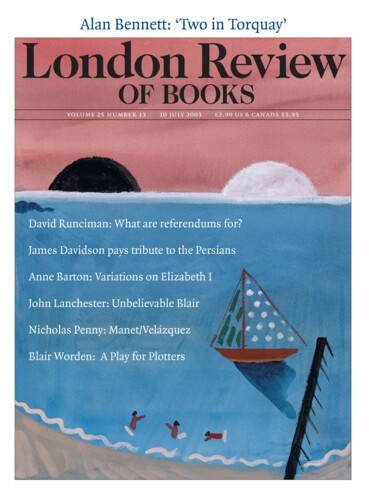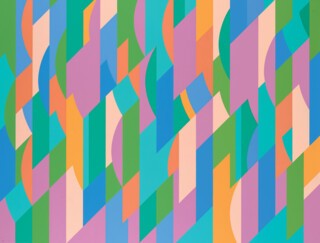One of the subtlest and most entrancing of Bridget Riley’s early paintings, Static 2 (1966), consists of a field of black spots arranged in a pure grid, 25 by 25, across a white square. Static, as the title says, and yet the painting isn’t inert: a lovely sense of inner movement is conveyed by the way the spots, which are not pure circles but mildly oval, are systematically shifted in their orientation around the canvas so that the stolid grid is forever displacing its balance just a little, as if a millipede were shifting its weight from foot to foot. The painting gracefully combines the classical ideal of stability with Romanticism’s restless play of unresolvable tensions.
So Riley is not all eye-searing dazzle; the relentless intensity of her paintings has not restricted its range of feeling. This soon becomes apparent in the retrospective at Tate Britain until 28 September. The pleasures of her earlier work are intimately connected to sensations of pain: the sublime that overwhelms rather than the beauty that seduces. If it’s a strain to look at the blazing, almost ungraspable Late Morning (1967-68) or Pæan (1973), then the paintings with braided stripes, such as Orient 4 (1970), are a bit kinder on the eye, and one begins to identify a sort of narrative sequence: ‘a cyclic movement of repose, disturbance and repose’, as she herself put it early on. All her paintings from this period have an element of conflict, evoking and containing sensations of distress, implying afflictions that are not just physical.
What about the work Riley has produced since then? Her last big show, three years ago at the Dia Center in New York, surveyed the first quarter-century of her career – from 1961 to 1984. The last one here in London, at the Serpentine Gallery the year before, covered only the 1960s and 1970s. It seems we’re still having trouble getting the hang of her more recent work. One reason is that our image of her art is so bound up with its first clamorous appearance. Riley’s black and white paintings of the early 1960s are among the icons of that decade. They penetrated as far into popular culture as the Pop Art overtly derived from it, and further than the abstract work of the time that is more revered by art historians, such as Frank Stella’s stripe paintings or Donald Judd’s boxes.
The word ‘icon’ evokes precisely the graphic, sign-like aspect of Riley’s early paintings, but this is something she seems always to have wanted to get away from. For Riley, it was never about constructing an image out of circles, squares, triangles, lines, or what have you. As she recalled in an interview a decade later, this vocabulary had become usable only when such structural elements ‘were no longer burdened by the heavy load of associations and symbolic overtones which they had carried in the 1920s and 1930s as Constructivist motifs’. What counts is not what’s on the canvas but what happens in the eye and mind of the beholder. ‘Don’t look at it,’ she once decreed.
For Riley, perception, not paint, is the medium and so, when she switches from emulsion to acrylic to oil, the change is almost unnoticeable. Compare Barnett Newman’s switch from oil to acrylic towards the end of his life (as seen in his recent retrospective at Tate Modern). In the present era of non-painting painters such as Damien Hirst and Jeff Koons it seems impressive that Riley knew as early as 1961 that it would be superfluous to paint her own paintings. Her contemporaries at the Royal College in the early 1950s included Frank Auerbach, Robyn Denny and Joe Tilson; the decision to forgo the pleasure of manipulating paint and use assistants to execute the work could hardly have been obvious at the time. Across the Atlantic, Alexander Liberman was having paintings produced commercially using refrigerator enamel. He came in for enormous criticism from his colleagues – only the up and coming Frank Stella defended him, and even then with a backhanded compliment: ‘He’s a good painter when he doesn’t paint.’
Riley, like Liberman, intended no break with tradition – neither a Duchampian gesture of indifference nor a manifestation of the ‘end of painting’ comparable with Rodchenko’s triptych of red, yellow and blue monochromes, ordered by telephone from the shop. Instead, she was reclaiming the Renaissance understanding of painting as ‘una cosa mentale’, in Leonardo’s words, and of drawing as the essence of the artist’s work – an understanding down-played ever since the Impressionists. Riley synthesised the intellectualism of the Renaissance with the Impressionists’ realisation that perception, too, is a mental activity.
A definite change in the emotional tenor of her work took place around 1981, when she began to use oil with the series of what she calls ‘Egyptian palette’ paintings: stripe paintings quite different in character from those of the previous decade – much more open, atmospheric and habitable, composed rather than structured. In a conversation published in 1990, she speaks of the change as follows: ‘I used to build up to sensation, accumulating tension until it released a perceptual experience. Now I try to take sensation as the guiding line and build, with the relationships it demands, a plastic fabric which has no other raison d’être except to accommodate the sensation it solicits.’ Riley seems to be saying that in the 1960s and 1970s she was working primarily on structure – always looking for the moment when a structural effect would become a vivid sensation, but without knowing in advance just what this would be; and that more recently she had begun with a specific visual sensation in mind, and looked for the structure that would support it.
This distinction, between building up to a sensation and working from it, may sound like something of greater importance to the artist than to the viewer, but that’s not how it turns out. Instead, because the desired effect is preconceived, the more recent paintings are invested with a noticeably lower degree of tension. The cycle of ‘repose, disturbance and repose’ in the earlier work turns out to have derived its power from the fact that it reflected the painter’s anxiety about the unpredictable making of the paintings – after so much planning, this is still an all-or-nothing wager. Can it be that Riley was a sort of hands-off expressionist? Her recent paintings display less vulnerability, and are the less overpowering for it.
Send Letters To:
The Editor
London Review of Books,
28 Little Russell Street
London, WC1A 2HN
letters@lrb.co.uk
Please include name, address, and a telephone number.


